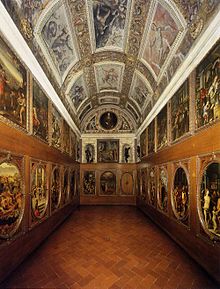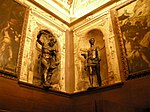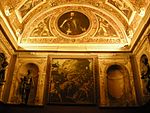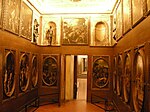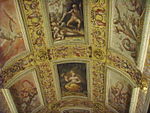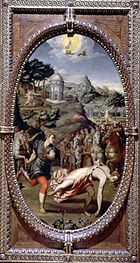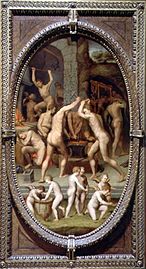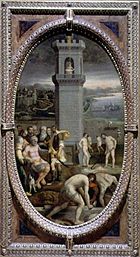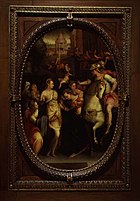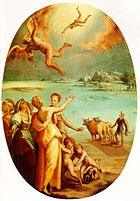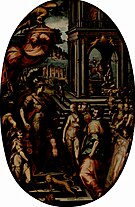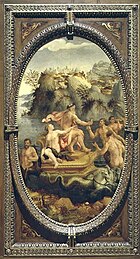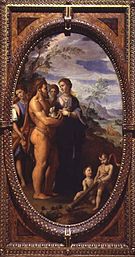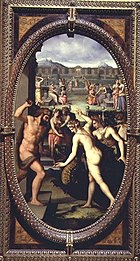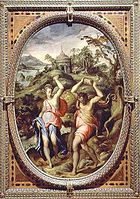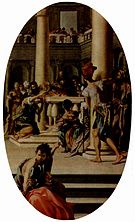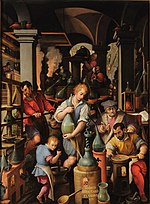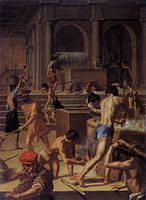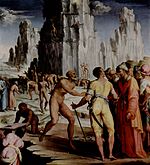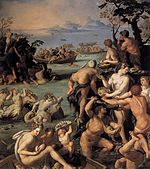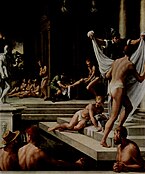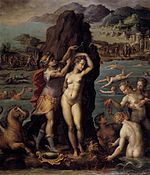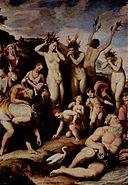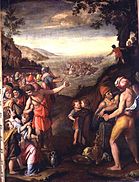
Alessandro di Cristofano di Lorenzo del Bronzino Allori was an Italian painter of the late Mannerist Florentine school.

The Palazzo Vecchio is the town hall of Florence, Italy. It overlooks the Piazza della Signoria, which holds a copy of Michelangelo's David statue, and the gallery of statues in the adjacent Loggia dei Lanzi.

The Palazzo Pitti, in English sometimes called the Pitti Palace, is a vast, mainly Renaissance, palace in Florence, Italy. It is situated on the south side of the River Arno, a short distance from the Ponte Vecchio. The core of the present palazzo dates from 1458 and was originally the town residence of Luca Pitti, an ambitious Florentine banker.

Jacopo Ligozzi (1547–1627) was an Italian painter, illustrator, designer, and miniaturist. His art can be categorized as late-Renaissance and Mannerist styles.

Jacopo da Empoli was an Italian Florentine Reformist painter.

Giovanni Battista Naldini (1535–1591) was an Italian painter in a late-Mannerist style, active in Florence and Rome.

Francesco Salviati or Francesco de' Rossi was an Italian Mannerist painter who lived and worked in Florence, with periods in Bologna and Venice, ending with a long period in Rome, where he died. He is known by various names, usually the adopted one of Francesco Salviati or Il Salviati, after an early patron, but also Francesco Rossi and Cecchino del Salviati.

Francesco d'Ubertino Verdi, called Bachiacca. He is also known as Francesco Ubertini, il Bacchiacca (1494–1557). He was an Italian painter of the Renaissance whose work is characteristic of the Florentine Mannerist style.

Maso da San Friano (1536–1571) was an Italian painter active in Florence. His real name was Tomaso D'Antonio Manzuoli. He was born in San Friano and died in Florence.

Francesco Morandini was an Italian painter active in Florence, working in a Mannerist style. He was also called il Poppi after his native town. He was a pupil of Vincenzo Borghini, and later he was Giorgio Vasari's assistant for many years.

Jacopo Zucchi was a Florentine painter of the Mannerist style, active in Florence and Rome.
Events from the year 1560 in art.

The Lives of the Most Excellent Painters, Sculptors, and Architects, often simply known as The Lives, is a series of artist biographies written by 16th-century Italian painter and architect Giorgio Vasari, which is considered "perhaps the most famous, and even today the most-read work of the older literature of art", "some of the Italian Renaissance's most influential writing on art", and "the first important book on art history".
Louis Alexander Waldman is an American art historian and author specializing in the Italian Renaissance.

The Basilica of Our Lady of Humility or Madonna dell'Umiltà is a Renaissance-style, Roman Catholic Marian basilica in Pistoia, region of Tuscany, Italy.

Santo Stefano dei Cavalieri is a church in central Pisa located on Piazza dei Cavalieri.
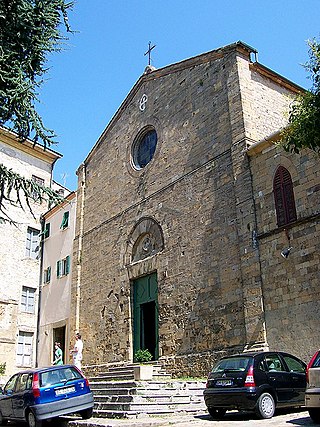
The church of San Francesco is an ancient church in Volterra in the province of Pisa.

Volterra Cathedral is a Roman Catholic cathedral in Volterra, Italy, dedicated to the Assumption of the Virgin Mary. It is the seat of the bishop of Volterra.

An anonymous author known as the Anonimo Gaddiano, Anonimo Magliabechiano, or Anonimo Fiorentino is the author of the Codice Magliabechiano or Magliabechiano, a manuscript with 128 pages of text, probably from the 1530s and 1540s, and now in the Central National Library of Florence. It includes brief biographies and notes on the works of Italian artists, mainly those active in Florence during the Middle Ages. Among several other suggestions, the anonymous author has been suggested to be Bernardo Vecchietti (1514–1590), a politician of the court of Cosimo I. The author clearly had intimate access to the Medici court.
